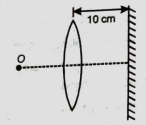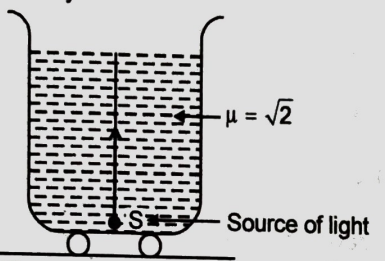If the focal length of the objective lens is increased, then magnifying power of :
(a) microscope will increase but that of telescope decrease
(b) microscope and telescope both will increase
(c) microscope and telescope both will decrease
(d) microscope will decrease but that of telescope will increase
यदि अभिदृश्यक लेंस की फोकस दूरी बढ़ जाती है, तो आवर्धन क्षमता:
(a) सूक्ष्मदर्शी की बढ़ेगी परंतु दूरबीन की घटेगी
(b) सूक्ष्मदर्शी और दूरबीन दोनों की बढ़ेगी
(c) सूक्ष्मदर्शी और दूरबीन दोनों की घटेगी
(d) सूक्ष्मदर्शी की घटेगी परंतु दूरबीन की बढ़ेगी
(a) microscope will increase but that of telescope decrease
(a) सूक्ष्मदर्शी की बढ़ेगी परंतु दूरबीन की घटेगी
Assertion: A convex lens may be diverging.
Reason: The nature of a lens depends upon the refractive index of the lens and that of the surrounding medium.
(1) Both Assertion and Reason are true and the reason is the correct explanation of the assertion.
(2) Both Assertion and Reason are true but the reason is not the correct explanation of the assertion.
(3) Assertion is a true statement but Reason is false.
(4) Both Assertion and Reason are false statements.
अभिकथन: उत्तल लेंस अपसारी हो सकता है।
कारण: एक लेंस की प्रकृति लेंस के अपवर्तनांक और आसपास के माध्यम पर निर्भर करती है।
(1) अभिकथन और कारण दोनों सत्य हैं और इसका कारण अभिकथन की सही व्याख्या है।
(2) अभिकथन और कारण दोनों सत्य हैं लेकिन इसका कारण अभिकथन की सही व्याख्या नहीं है।
(3) अभिकथन एक सत्य कथन है लेकिन कारण असत्य है।
(4) अभिकथन और कारण दोनों ही असत्य कथन हैं।
An air bubble in a glass slab with refractive index 1.5 (near normal incidence) is 5 cm deep when viewed from one surface and 3 cm deep when viewed from the opposite face. The thickness (in cm) of the slab is
| 1. | 8 | 2. | 10 |
| 3. | 12 | 4. | 16 |
अपवर्तनांक 1.5 की एक काँच स्लैब में हवा का एक बुलबुला (अभिलम्बवत आपतन के निकट) 5 cm की गहराई पर है, जब इसे एक फलक से देखा जाता है और 3 cm की गहराई पर है, जब इसे विपरीत फलक से देखा जाता है। स्लैब की मोटाई (cm में) है:
| 1. | 8 | 2. | 10 |
| 3. | 12 | 4. | 16 |
A point object O is placed at distance 20 cm from a biconvex lens of radius of curvature 20 cm and =1.5. The final image produced by lens and mirror combination will be at

(1) 10 cm from the mirror
(2) 20 cm from lens
(3) -20 cm from lens
(4) -15 cm from the mirror
एक बिंदु वस्तु O को 20 cm वक्रता त्रिज्या और = 1.5 के उभयोत्तल लेंस से 20 cm दूरी पर रखा गया है। लेंस और दर्पण के संयोजन द्वारा निर्मित अंतिम प्रतिबिंब कहाँ पर होगा?

(1) दर्पण से 10 cm पर
(2) लेंस से 20 cm पर
(3) लेंस से -20 cm पर
(4) दर्पण से -15 cm पर
A concave and convex lens has the same focal length of 20 cm and are put into contact to form a lens combination. The combination is used to view an object of 5 cm length kept at 20 cm from the lens combination. As compared to the object, the image will be
1. Of the same size as the object and erect
2. Of the same size as the object but inverted
3. magnified and inverted
4. Reduced and erect
एक अवतल और उत्तल लेंस की समान फोकस दूरी 20 cm है और एक लेंस संयोजन बनाने के लिए संपर्क में रखे जाते है। संयोजन का उपयोग लेंस संयोजन से 20 cm पर रखी गई 5 cm लंबाई की वस्तु को देखने के लिए किया जाता है। वस्तु की तुलना में, प्रतिबिंब होगा
1. वस्तु के समान आकार का और सीधा
2. वस्तु के समान आकार का लेकिन उल्टा
3. आवर्धित और उल्टा
4. छोटा और सीधा
Assertion: For observing traffic at our back, we prefer to use a convex mirror.
Reason: A convex mirror has a much larger field of view than a plane mirror or a concave mirror.
अभिकथन: अपने पीछे का यातायात देखने के लिए, हम उत्तल दर्पण का उपयोग करना पसंद करते हैं।
कारण: उत्तल दर्पण में समतल दर्पण या अवतल दर्पण की तुलना में बहुत बड़ा दृश्य क्षेत्र होता है।
- If both the assertion and the reason are true and the reason is a correct explanation of the assertion
- If both the assertion and reason are true but the reason is not a correct explanation of the assertion
- If the assertion is true but the reason is false
- If both the assertion and reason are false
Assertion: The air bubble shines in water.
Reason: Air bubble in water shines due to the refraction of light.
(1) Both Assertion and Reason are true and the reason is the correct explanation of the assertion.
(2) Both Assertion and Reason are true but the reason is not the correct explanation of the assertion.
(3) Assertion is a true statement but Reason is false.
(4) Both Assertion and Reason are false statements.
अभिकथन: हवा का बुलबुला जल में चमकता है।
कारण: प्रकाश के अपवर्तन के कारण जल में हवा का बुलबुला चमकता है।
(1) अभिकथन और कारण दोनों सत्य हैं और इसका कारण अभिकथन की सही व्याख्या है।
(2) अभिकथन और कारण दोनों सत्य हैं लेकिन इसका कारण अभिकथन की सही व्याख्या नहीं है।
(3) अभिकथन एक सत्य कथन है लेकिन कारण असत्य है।
(4) अभिकथन और कारण दोनों ही असत्य कथन हैं।
A converging spherical wavefront is obtained from
(1) Light emerging from a convex lens when a point source is placed at its focus
(2) A parallel beam of light incident on the convex lens
(3) Light converging at a point
(4) Both (2) & (3)
एक अभिसारी वृत्तीय तरंगाग्र किससे प्राप्त किया जाता है?
(1) उत्तल लेंस से उत्सर्जित प्रकाश, जब किसी बिंदु स्रोत को उसके फोकस पर रखा जाता है
(2) प्रकाश की एक समांतर किरण पुंज उत्तल लेंस पर आपतित होती है
(3) एक बिंदु पर अभिसारी प्रकाश
(4) दोनों (2) और (3)
A point source of light is emitting light in a vertically upward direction and the container is filled with a liquid of refractive index . If it starts accelerating along the x-axis with acceleration , the light coming out of liquid os deviated by
1.
2.
3.
4.
प्रकाश का एक बिंदु स्रोत एक ऊर्ध्वाधर दिशा में प्रकाश उत्सर्जित कर रहा है और पात्र को अपवर्तनांक के तरल से भर दिया गया है। यदि यह X-अक्ष के अनुदिश त्वरण के साथ त्वरित होना प्रारंभ करता है। तरल से निकलने वाला प्रकाश किस कोण से विचलित होता है:

1.
2.
3.
4.
What should be the angle between two plane mirror, if an object placed unsymmetrically between them has five images?
1. 75
2. 60
3. 120
4. 59
यदि किसी वस्तु को दो समतल दर्पणों के बीच असममित रूप से रखने पर उसके पाँच प्रतिबिंब बनाते हों तो समतल दर्पणों के बीच का कोण क्या होना चाहिए?
1. 75
2. 60
3. 120
4. 59






